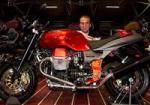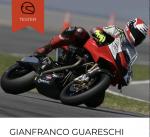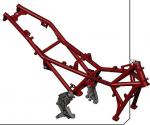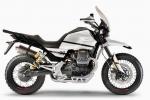
ScuRoo
Members-
Posts
742 -
Joined
-
Last visited
-
Days Won
22
Content Type
Profiles
Forums
Events
Gallery
Community Map
Everything posted by ScuRoo
-
Less than 200kg & 21L tank. Excellent. Translated from https://www.cafe-racer.fr/moto-guzzi-v85-la-tt-en-premiere-de-cordee/ Moto Guzzi V85: the first TT of roped By Bertrand - September 11, Engine, look, concept: since the presentation of the prototype at the last Eicma, late 2017, the V85 is eagerly awaited by the world Guzzi. The veil on the final version last weekend, at the Open House of Mandello del Lario, has only increased the enthusiasm for this brand new machine, which announces a full range of products. a new block. This final version is very close to the proto of Milan: only the front has been slightly modified, with a tubular mesh spider to support the dual optics, previously secured to the handlebars. The ergonomics of the saddle has been reworked. But the TT, since this is its final name, is in every way in line with the original concept: "As soon as we launched this project two years ago, says Marco Lambri, the director of design Piaiggio group, our desire was clearly to develop a classic trail, in line with our motorcycles of the 80s, including the V65TT. These trails of the 80s were simple and robust, and corresponded perfectly to the expectations of bikers. We think this concept is still valid today: who really needs a 150 horsepower engine and a 30 liter tank on a trail? But at the same time, we wanted to combine a classic style with current equipment and behavior, which was not necessarily easy to achieve. We have nevertheless succeeded, and TT has all the elements of a modern motorcycle, starting with electronics with different driving modes, ABS, traction control, cruise control ... " This modernity is embodied in the onboard computer, splendid: the brightness of its large screen is automatically adjusted. Modern also the tank, since for the first time for its classics, Guzzi abandons a real tin can for an element hidden under two plastic covers. "It's part of our hunt for extra pounds," says Lambri. This tank dresses a new tubular frame stiffened by two aluminum side plates. The wheels are 19 for the front, 17 for the rear. No measure is given yet since the motorcycle is passing at this moment the homologations necessary to put it in production. We simply know that the tank has a capacity of 21 liters, that the weight does not exceed 200 kg. And do not be a giant to have both feet on the ground. With the V85TT, Moto Guzzi is launching a brand new 853cc engine on the market. While it retains the basic features of the V7 and V9 ranges: air cooling, two valves per cylinder, distribution by rockers ... But it has been completely redesigned with a lighter crankshaft of 30%, large 53 mm intake bodies , larger valves, and titanium for admission, pistons short skirt ... The goal is clearly to take turns to win horses: this V85 is announced for 80 horses, an increase of 45% over at V9. The maximum torque is announced for 80 Nm at 3,400 revolutions. The V85TT will go into production at the beginning of January for an arrival in concessions from February 2019. Our Italian colleagues of Motociclismo, who could try the proto, announce a sale price around 11 500 euros. Marco Lambri, meanwhile, announced the development of a full range around this new engine that finally fills the performance deficit regretted by fans of V7 and V9. A "more road" proto will be presented at the next Eicma
-
I checked search but found no entry on the passing of Ivano Beggio (earlier this year) so thought worth posting what I only recently became aware of myself. It’s appropriate to probably acknowledge him as the Father of our magnificent V11’s if he commissioned Marabese for the design. His contributions to the Italian motorcycle racing and development of riders like Rossi etc is very interesting...
-
Swooshdave “Torque - 115Nm@6000 vs 94Nm@6000rpm“ The R9T Scrambler reads 21Nm more torque than the V11 - plus weighs less. I agree with you about torque, it’s definitely somewhere in there... but “More torque = more fun.” doesn’t really explain it when the V11 has the lesser sum of 94Nm. I grew up riding horses - & the length of the cannon bone (between knee & fetlock) used to be evaluated in assessing suitability of the horses confirmation depending on what performance discipline you wanted to do, ie., dressage, show jumping, race horse etc. So, to my mind I relate that back to the ‘confirmation’ relationship between crankshaft stroke AND conrod length. Somehow, Guzzi horses have that perfect ‘Champions’ confirmation. The elusive ‘Phar Lap’, ‘Winx’ and ‘Black Caviar’ X factor! That’s it! Guzzi’s got it - “Long-legged and easy to live with!”
-
Been trying to identify the rider in the picture posted previous page - and found this quote in an interview of Gianfranco with his picture tagged TESTER. Also, brother Vittorianno was development rider for the Ducati MotoGP entry, the Desmosedici before later being made team manager. Now, the wearing of Ducati gloves & helmet in picture is clearly odd - so putting the available evidence together I’m wondering whether one or other (or both) of the brothers is the unidentfied rider... New Guzzi bike, Ducati gear, long-term family Guzzi dealer connection, Guzzi racers, tester/development histories, rider style shows expert status... Hmmm!
-
Focussing solely on and second guessing what the actual horsepower figure eventuates as is a little bit of a mute point - after all it is what it is, 850cc! Moto Guzzi should be congratulated for redesigning and offering riders an air-cooled option which can comply with the Euro5 emission impositions. Other manufacturers like BMW et al, have bailed out and all gone water cooled. I’m loving their contrarian mindset to just say, Hey guys, let’s go swimming upstream and see how much power and efficiency we can screw out with shaving crankshaft weight, titanium valves etc. I know it’s all in the eye of the beholder, but for an Adventure bike, I think this TT is absolutely stunning! I’m not being visually wooed with all the others stark, sharp plastic lines and fancy pants headlights! It’s cool, it’s classic. We’ve clearly been told there’s more coming along... so yep, maybe we should stick with faith, hope and love...
-
I think it might be worthwhile, at very least interesting, adding a couple of responses from the Spanish same site... Originally written by @Guzziamici From what I have read, they say that in 2021 (the centenariat), they want to close the circle ... but never again was it known about that engine project, a rumor of 1,200 or 1,300 cc liquid cooling. I hope that the big bet is a badly painted motorcycle like that orange california of the 90th anniversary (I think) We will see the comparisons of the V85 with the other brands and how it behaves in the market. Or that they take it out already and not within 2 years. In response to Guzziamici above Cabellero73es goes on to say... Yes it has been known. The new "big block" is announced by the boss of Piaggio, and there are several confirmations that he is working on it. Even in this test it is mentioned again that they will do it when they play ("possiamo farlo e lo faremo, at the moment opportuno"). That they take it out already and not in two years? But if they have been bored to say that the final model will be in November in Milan, to start manufacturing that month and the first deliveries in February. As for what you are saying about the Suzuki Vstorm, that is what there is in fact. Motorcycles light, logical and versatile in which you do not leave a kidney to buy, fun but comfortable to travel without being a transatlantic and operate in the city, short radio, weekend getaways and occasional trips of adventure. That other part of the market that has been lost when the production of the Norge and the Stelvio has stopped (which have always been very minor motorcycles, let's not kid ourselves), you will be able to re-attack when you have a new large block cooled by water, it is the only way to meet the increasingly restrictive Euro4 and especially the Euro5 that sooner or later will play. The only important data that we lack of the V85TT, in addition to confirming definitely that the price remains at 11-12, is the weight. Everything points to 220 kg in running order. If that's the case, it could be what I was reading a couple of days ago in a foreign forum: The Guzzi just at the right time .... Then, if the formula is successful, it is relatively easy to dress it with other clothes and fill a couple of gaps in the catalog ...
-
This following contribution provides more detail and is translated from a Spanish forum... # 261 · 25 / Aug / 2018, 12:39 · Edited by caballero73es Things that can be read in the report, some new, some already known ... but as a summary what I understood: - Engine: It is the block of the v9 completely redesigned. They reiterate questions that we already knew about the previous Motorcycling report about the engine. 853 cc. 80 HP of maximum power, 80 Nm of torque from 3,400 rpm. At 5,000 turns it holds 130 km / h. Cut at 7,500 rpm. 52mm butterfly body (the V9 has 38mm), 2 valves per cylinder, with more radical geometry, titanium outlet, semi-dry carter with two lubrication pumps (controlled by chain), new crankshaft with 30 % less weight (do you remember that news from two years ago about the development of a new crankshaft in Noale for Guzzi?), reinforced rods and shorter pistons. Reinforced motor block. It complies with Euro4 and will comply with Euro5 when it is implanted (says that working more on the catalyst). - Switchboard: Here they highlight a work in depth, which is not yet finished (in fact, the motorcycle of the test has not yet installed them at all). Three main modes: Road, Rain and Off Track. The management maps not only control the injection, but also the traction control and the ABS. As an example, the Off-Road mode overrides the rear ABS and makes the front as less invasive as possible. As we already knew, the accelerator is electronic (ride-by-wire) - Gearbox: New, with new synchronizing systems. Both the engineer and the tester, say it goes like silk and the "clonk" of the first has disappeared ... we will miss it! - Chassis, new design from scratch. They include a rendering of it. Additionally, the rear tubular structure is added as anchor for side cases and with the trunk anchor included. The swingarm has been lengthened by 70mm compared to that used by the V9 to adapt to the monoshock and to gain stability at high speed. The tested model has no trestle installed, but the axle of the rear wheel has two lugs for a shop storage rack. I understand that that will probably change in the final model. Both the rear brake pedal and the change pedal are adjustable. - Suspensions: The known, although there are no Öhlins here ... The rear shock absorber monkey has 7 positions of preload and regulator of the hydraulic extension. The fork is equally adjustable, but only in the right bottle. - Brakes: radial Brembo with two 320mm floating discs in front and normal disc behind. - Tires and tires: Metzeler Karoo Street and Tourance Next are mounted on the preserver bikes. The radio tires go with an air chamber. - Escape: 2 in 1, with catalyst and presilenciador located under the engine (behind the crankcase). It is protected by the cover carter, although the photos do not look very good if the protection is long enough. - Deposit: 21 liters, made of plastic material. In tests, at a strong pace, the on-board computer showed an average consumption of 19 km / l. Come on, we talked about 400 km of autonomy cheerfully. - Lights: Full Led as it is now said ... the rear wheels are circular (the opening bowler hat is just below the rear pilots). By the way, maybe it was obvious ... but the headlights are fixed, do not rotate with the fork. - Instrument panel: Although it has been the subject of internal debate ... it is the first Guzzi without analog instrumentation. Color picture and with information at hand. Automatic variable lighting. Of the included image that I already put, it is deduced that it takes of series the multimedia system of connection with mobiles and perhaps with helmets bluetooh ?. - Screen: They indicate that it has two positions, one more vertical than the other, manually modifiable with a tool (the tester suggests that in the final version the allen screw system be replaced by bolts that allow it to be made by hand). Enough to remove air from the chest and without generating excessive turbulence in the helmet (although he wears a cross-type helmet and says that some candle effect makes him), thanks to its peculiar design. I imagine that the variants of this screen are going to be an aftermarket hit ... - Posture: Comfortable, with open and wide handlebars (in the photos it looks pretty good when it is curving and how separated are the hands). The pedals allow the legs to be quite distanced from the cylinders, as confirmed in the photos, in fact he comments that the heat of the engine is not too noticeable but something more in the feet, coming from the collector-catalyst that is located in the part down. The seat is one piece, says that comfortable and wide for the pilot, although he indicates that he would like the front area to be a little narrower. - Libreas: Although they had hinted at something else, it seems that finally this white and yellow livery will be a tribute to Claudio Torri's motorcycle in the 1985 Dakar. But also, in monochromatic scheme of a color combined with the red chassis. At the moment, in addition to the black of the preserie units, we have seen photos of a model in dark blue and another in green Legnano: l) - Test: 300 km of curves from Noale. In one of the photos come 4 V85TT, the three blacks used for the tests, and the one that comes with livery. The enthusiasm of the tester regarding the bike is evident, but good here everyone will have their opinion on the degree of realism of these sponsored tests. - Future models. Here we repeat two things that we already knew ... that with this base of engine and chassis are already working on another model, a motorcycle "road" with wheels of 17 ", and that this engine will not be increased later, What they are working on is another type of design. It is again expressly stated that the intention is to offer a motorcycle technologically up to date, but simple and without complications, with a clear objective, which are the new guzzistas that have entered the brand with the V7. Of everything that I am seeing and reading ... I am quite clear about it; This is the first Guzzi 100% Piaggio, where the Aprilia people have been fundamental in the technical improvement of the bike. We'll see if the result warrants it ...
-
-
-
-
-
-
Scud You probably know better than me - but my regular riding mate has a R9T scrambler and I’m on a V11 ScuraR. The stats say... Power - 110HP@7750rpm vs 91HP@7800rpm Torque - 115Nm@6000 vs 94Nm@6000rpm His Wet weight 220kg. My Dry weight 226kg. Now, anyone looking at those figures (myself included) would overwhelmingly be expecting there’s no bloody contest... However, I’m writing for one reason only. Shock! Genuinely, I’ve been utterly shocked at how unreliable paper figures actually work out to be on the road...! Only when there is a long, flat straight, top gear max revs does the R9T have the top end overtake advantage - apart from that scenario it’s wafer thin from point A to B. I’ve even noticed, on rising slopes or hills the scrambler can’t seem to reel the V11 in like on the flat or down hill stretches. So, it’s seems true, Guzzi horses really are “big” horses - and I often wonder what is that actual secret ingredient? It really makes little sense, but still I’m of the view it must be the extra crank stroke length - and possibly some sort of inherent ‘sweet spot’ with the stroke/rod length ratio. Even the aural experience of Guzzi’s V11 syncopation is unmatched - say compared to other like for like 90 degree V-twin architecture, eg., Suzuki’s SV1000 (another mate has one). ... I actually wanted to contribute something useful but unfortunately it’s difficult unpicking or to tease out what I discern inside when out on the road. It truly is a mystery but I’ll wrap up by making this observation - it seems unnervingly illegitimate that I should be punching above my weight but my smile is biggest when I surprise riders with bikes with those better “figures”. So I just find it easiest over a beer explaining, ‘Guzzi horses are big horses’ - without exception, they always nod in agreement.
-
My Moroccan trip on the Quota 1100es was a revelation in how competent and tough Guzzi designed and made that particular bike. So as a comparison here are its salient attributes: Max power: 70HP @ 6200rpm Max torque: 85Nm @ 3600rpm Dry weight 245kg (& 5 speed) Motorbox confirms this smallblock V85TT as 80HP and has 80Nm @ 3400rpm at near as fly dirt to 200kg. IMHO If the price is right, this bike will sell like there’s no tomorrow...
-
I noted some dislike the “Ronald McDonald” yellow concept colour scheme but seems Piaggio might be planning on more monochromatic offerings too...
-
-
Translated from Czech: Chief of the technical group Piaggio Group talked about the technical details of the new V85 engine. Moto Guzzi V85 has become the winner of the vote for the general public at the EICMA 2017, and so great expectations are met. And they also enjoy great attention. That's why Antonio Cappellini - the number one person in the Piaggio Group design - has expressed it. The V85 is significantly different from the V7 and V9 engines. It's not just a difference in the drilling and lifting of the pistons, the changes inside the engine are all pleiades. We start with titanium valves weighing half that of steel. Their lower inertia forces a higher increase in speed and power. In order to better feed the mixture, the throttle diameter was increased from 38mm to 52mm. It is controlled by ride-by-wire over several different fuel maps. This new throttle also has an innovative traction control that will work more gently than engaging the previously used ignition off. Moto Guzzi V85 - winner of the vote of the EICMA The crankcase is not wet as with V7 / V9 but is semi-dry. Two oil pumps are now available for lubrication. One is pressure and the other suction. In engine V7, the oil was sent to the top of the head, from where it flowed back down into the engine. At V85, the oil circuit is forced through two pumps. The result is better oil cooling and a great deal of lubrication from the crank where there are great piston pressures. With these pressures the oil was unnecessarily heated. The cylinders still have two-valve technology. However, the engine meets Euro4 and will meet Euro5. It has a performance of 80 hp, which is a beautiful shift compared to 55 hp on the V9 engine. It also helps with the new crankshaft, which is made of more rigid materials and therefore can be lighter. All the other shafts in the engine and gearbox are also lighter and, along with other changes, nearly 30% of the weight is saved on the engine's interior. This lighter engine interior also contributed to a significant reduction in vibrations and to a steady torque curve, which is totally equal from 3400 rpm. The engine's engine is completely new. It is more robust, because the engine itself will be a part of the frame. The entire set with a small frame will achieve excellent stiffness, comparable to the Stelvio 1200 model. While the V85 will not be able to compete with the Stelvio 1200, the V85 will be lighter and the power / weight ratio will be at 800cc. Moto Guzzi V85 has a dry clutch again. The gear selector has been redesigned, so you will no longer hear the classic clutter when running on neutral. A silentblock was mounted on the cardan wings to make the shot softer. The engine itself will not be sold in different power versions. It is designed for 80 horsepower and will be assembled. However, it is clear today that the V85 will also appear in other segments, and the road version is already working. Will it be a new version of the V9 series? The non-finalized prototype shows what we wrote in our earlier article. That EICMA showed the bike what it might be, not what it really is. The center of attention was Brembo M50 and Ohlins chassis, which both components got on the new prototype to the price of reasonable limits. In front, the Brembo P4.34 brakes, the Marzocchi front shock absorber and the rear Sachs silencer have been installed. At the EICMA prototype the lights, LCD and plexi label were anchored in the glasses steering. Now the lights, the LCD and the plexus are independently anchored directly to the frame and therefore there has been added a massive scaffold that holds it all. This was positively influenced by maneuverability, especially with faster turnarounds. http://motosvet.cz/testy/373-detaily-motoru-moto-guzzi-v85.html
-
The secrets of the Moto Guzzi V85 engine Antonio Cappellini - responsible for the design of the Piaggio group - reveals the secrets of the two-cylinder Moto Guzzi V85. Titanium and maniacal valves seeking lightness to increase power and make the delivery smoother, as well as semi-dry crankcase lubrication At the last Motor Show in Milan, Moto Guzzi presented the prototype of the V85 endurona. In the last few months we interviewed Marco Lambri, the person in charge of the bike line, who told us some anecdotes about the birth of this bike. Now instead the word goes to Antonio Cappellini - number one of the design of the Piaggio group - that exclusively for Motociclismo unveils the secrets of the twin-cylinder Moto Guzzi V85. Off-road rider, amateur rider of motocross and husband of a motorcyclist who in his youth guided the Aspes Hopi (and who knows if he knows that the 125 Gallarate was a nice peperino!) Cappellini does not skimp information on the new engine dell'endurona. The secrets of the Moto Guzzi V85 engine A new Guzzi engine is always a highly anticipated event not only by the enthusiasts of the Mandello del Lario brand. Really this V of 90 ° is different from the two-cylinder that equip the custom V9 and the naked V7 III? "It derives from the V9 engine, but only in architecture and bore and stroke measurements; the analogy ends here and can be considered a whole new engine. And I explain why. Let's start by saying that the lubrication is a semi-dry crankcase and not a wet sump. We have two coaxial pumps instead of one; they are used for the delivery and to recover the lubricant. In the old V7 engine all the oil was sent to the top of the heads and less to other parts. Of course, so exposed to the air it cooled well and lowered the temperature of the hottest area, but it was not the best for general lubrication. We are so sure of the performance of this semi-dry system that we do not even have an oil cooler. With the semi-dry solution we also have a crank shaft crankcase completely insulated, avoiding the possible absorption of power deriving from an "open" solution where the piston must also overcome the back pressure inside the crankcases ". But how did you manage to increase the power up to 80 hp? The V9 has only 55. A nice step forward. "Everyone thinks that this engine has four valves per cylinder for this performance. Actually we only have two. It was a good undertaking to get 100 HP / liter from an air-cooled engine while maintaining the distribution to rods and rocker arms. However, we wanted to respect the classic technical architecture of Guzzi engines ". What is the secret to having these benefits? "Having a titanium intake valve. It weighs half of an analogous steel and this has allowed us to adopt a geometry of the opening of the valves much more radical. We still used only one intake manifold, but with a throttle body of 52 mm in diameter against 38 mm of that of the peaceful V9. In addition, the accelerator is ride-by-wire, while the other has a mechanical drive. With the electronic throttle control, engine management is facilitated and we can better manage the entire supply, starting with the various mappings and the traction control system. But we did not stop here in the technical review of the V9. Because the V85 has a new crankshaft, several stiffer connecting rods and even shorter-clad pistons. We have saved almost 30% of the weight of the embellishment. And this has allowed us to cut the vibrations drastically even at maximum speed ". The frame is completely different from those of the history of the twin-cylinder V7, so much so that the engine has become an element of stiffening of the entire structure. Did you have to intervene on the base? "Yes, the carter are all new, sturdier just to give greater rigidity because I wanted a frame that would allow you to enter the curve with the same precision and solidity of our Stelvio. And I told my engineers: 'As long as I do not feel the tread that rubs on the asphalt I'm not happy'. And touch, I assure you that it touches! We have also extended the swingarm to make the rear suspension work better and increase the driving precision on the fast ". The secrets of the Moto Guzzi V85 engine The V85 is born to confront with a fierce competition in the off-road sector, motorcycles that have brilliant engines ... "I assure you that this twin-cylinder will be quick and bright. We have a torque that expresses the maximum of its value of 80 Nm at only 3,400 rpm and its work curve is actually a straight line that remains so until the maximum of laps. Of course we can not compete with the twin-cylinder 1200, but we play with the competitors of equal displacement. We are there having a year around this engine and we have not finished yet, but we want to be sure to have a motor at the height of a great Guzzi. We could certainly build a liquid-cooled twin cylinder with four valves per cylinder - and we will do it - but we wanted to keep the image of a classic Guzzi at all costs ". Guzzi engines are recognized with their eyes closed not only for the sound to the exhaust, but also for that clock that accompanies the insertion of the gear. "You will not hear it anymore. Using a dry clutch, and ours is, when the first gear engages, the complete disengaging of the clutch allows the whole system of the primary transmission and the gearbox to turn quickly again. The clock that is heard derives from the engagement of the selector that collides with the fast rotation of the gears. With the friction in the oil bath everything is 'softer' and the noise is lower. But we worked hard to soften, even make this clock disappear and have more silent gearshifts than the six-speed gearbox. In addition we have put a damper on the output of the gearbox due to the increased power and to have an even 'softer' response to the final shaft transmission ". It has always been said that the ever more stringent anti-pollution regulations would not allow to keep the air-cooled engines ... "But this V85 is the proven proof that you can very well make a similar engine that passes the guillotine of emissions without problems. It was immediately OK for the Euro 4 and is already ready to adapt to the much more restrictive Euro 5. We will probably have to work hard on the catalysts, but with a power of 100 hp / liter there are no problems even with air cooling. And then this is an engine that consumes very little. If you think about it, it's a propeller that does not have too many components to absorb power. It has no cooling pump, it does not have long chains or distribution belts and the rod and rocker system is among the most parks in eating power ... And so we consume little ". Has it been studied to grow in displacement? "No. Not because it is not structured to accommodate a cubature even higher, but because it is born to have a balance between performance and lightness. And that's what we're looking for from a bike in this category ". Will it also be used for other models? "Yes: we are working on a road version that already today drives very, very well, and then on more ...". https://www.google.com.au/amp/m.motociclismo.it/moto-guzzi-v85-segreti-motore-intervista-cappellini-70088.amp
-
Hi fella's Been mulling over Docc's beer bottle mod - can the method be improved upon for the effectiveness to effort ratio? Pics first, then some thoughts to follow...
-
" Raceco UK October 4, 2017 · Raceco Moto Guzzi SS2 and SS3 camshafts will be produced during the month of October. Some will be available for outright purchase or you can send your cam to be re-ground. As there still a demand for these cams I intend to have a yearly batch done each autumn ready for winter rebuilds. Pictured is an SS3 cam that is currently available for outright purchase. Please get in touch with me by email at a.castellani1@btinternet.com if you are interested in purchasing a camshaft outright or would like your camshaft re-ground. The cams will be £175.00 GBP Sterling if reground on your original cam or on an exchange basis if available. Outright purchase, if available, will be £255.00. Carriage extra. As I'm having them done in bulk this is actually £20.00 cheaper than it was four years ago when I was running Raceco UK full time. For the big two valve Guzzis I would recommend the SS2. We have fitted many since the 80s to everything from T3, Californias, Converts to Le Mans 1,2,3, and 1000. A very flexible cam. Our best seller for many years. This can be used with standard springs that have been shimmed to 36mm. Pulls from 1,500 rpm with extra kick from 4,500 rpm. Information regarding the SS3 camshaft: Although the SS2 profile is different the cam fitted to the Sport 1100 and V11 as standard, it is very similar to the SS2 in terms of lift and duration. For this reason I developed the SS3 which does give a pretty big improvement. It is based on the RR3 cam that was used by Doctor John Wittner for racing at one point before he started using the "F" full race cam. The RR3 is suitable for high rpm road and race use and is more flexible than the "F" cam. It is a performance cam. It is a difficult cam to fit, will require different valve springs and top collars and in some cases machining of the valve seats so the valves do not touch on the overlap. A cam for the technically minded home mechanic or professional engine builder. "
-
Thanks for the links & report on your LED trial docc. Fortunate to find in time those meltdowns etc. I was all set to follow down the same path with this LED swap - until I noticed your late one night thoughts on its actual performance! The night riding aspect captures my interest. What's your conclusion here for increasing our V11's headlight capacity in lighting up the road ahead for better night riding vision? Is it that LED bulb swaps as a technology in general for V11's isn't all it's cracked up to be insofar as an upgrade for increasing night riding vision... or just this particular brand of LED bulb being a let down??
-
Fun, inspirational. Chuck, you've found the fountain of youth...
-
Bwahahaha! We've had some interesting footage Downunder here fella's… you guy's sure seem to have been having some fun & high-jinks in your neck of of the woods. So, who's the free world gonna end up getting…?
-
On the Megacycle listing for the 620x11 it is clearly described as the "Norris SS. Drag Race/Hi Performance" http://www.dpguzzi.com/megacams.pdf Now, Raceco also describes their improved SS2 thus: "Raceco’s SS2 camshaft is a development of the Italian SS (also known as P3) camshaft. The SS2 Cam has more duration and overlap than the old SS but still retains the low down pulling power with the added bonus of extra power at the top end. This is our most popular road cam. It has been fitted with excellent results to everything from Converts to LM5’s. This cam requires checking for valve to valve and valve piston clearances, components may have to be machined for correct fitting. We will fit it for you if you wish." http://www.raceco.com/motog.html So, the identity question remains, is the "Italian SS (also known as the P3) Raceco are referring to - actually the Norris SS, or has this "SS" designation been coincidently used twice, the Italian SS (or P3) and the US company Norris independently developed their own "SS" version…? Then again, Raceco describe their Raceco SS3 camshaft as: "Designed specifically for V11 and Sport 1100 type engines. As the original camshaft in these engines is very similar to the SS2, we have decided to make a more powerful alternative available." The Internet - all over the shop like a mad woman's breakfast. Grrrrr. So, in short, what's correct order of cams going from hot, hotter, hottest? Is the order 620x10, followed by the Raceco SS2, then 620x11…? Or is it - Raceco SS2, 620x10, then 620x11? Anyhow, one thing is clear - Kent Cams confirms they can reprofile a supplied V11 cam into the Raceco SS2 for GBP128 - & the GBP has Brexit plummeted!












